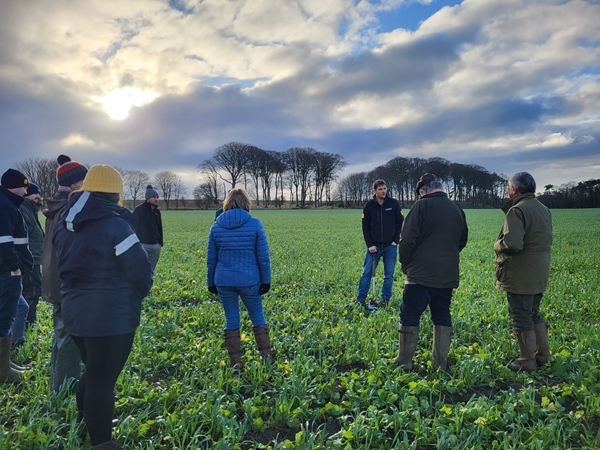By Fiona Torrance, Farmland Biodiversity Advisor, GWCT Scotland
Last year I was given the unenviable challenge of developing farmer clusters in Scotland. Although farmer clusters have been going in England since 2012 and have been immensely successful (with over 100 connected to GWCT now established) unfortunately in Scotland we have not seen this same level realised. So why is this, and what can we do to kick-start their uptake in Scotland?
The farmer cluster model is one that, with the correct support in place, has the potential to deliver multiple benefits for both wildlife and people. Collaborative projects are nothing new, but what sets clusters apart is their bottom-up approach, meaning that the groups are run and managed by the farmers themselves. This means they select their own facilitators, select the species/habitats they want to work on (with advice from their facilitator), and organise their own meetings, visits and other events.

PepsiCo FAB project farm walk. (Credit: Fiona Torrance)
Traditionally, these are groups of farmers who live locally, who can then work together to enable conservation measures to take place on a landscape scale, a strategy which research tells us is far more effective than working in small units. However, there may also be other benefits for the farmers themselves, including sharing of machinery, access to a trusted advisor, as well as the opportunity to interact with your neighbours and other stakeholders. Groups such as these also tend to be great at learning from each other, with many farmers choosing to listen to advice from their peers rather than external sources.
Sounds like a win-win right? If that’s you, then you might be wondering why this concept has not taken off in Scotland. After all, much of the farming system and wildlife present in the north and south of the border is similar. A potential answer to this question (along with many others I could ask you) is money. In order for a cluster to get off the ground, three key ingredients are needed: a group of farmers willing to work together, one of these farmers who is willing to take on the mantle of leading the group and, crucially, a facilitator.
The facilitator role in a cluster is key. Not only is this person trusted by the farmers to provide advice on how to conserve their agreed species or habitat of choice, but they also fulfil roles such as organising external speakers, coordinate any training required and, crucially, apply for funding so that the group can undertake some of their desired outcomes. In England, facilitators are supported through the Natural England Countryside Stewardship Facilitation Fund, but currently no equivalent funding exists in Scotland, meaning clusters must source their own funding before they’ve even hired an expert on how to do this.
It is true that other funding models exist. For the clusters that have managed to get off the ground in Scotland so far, they have all selected funding models suited to how they work. This might include applying for short-term grants from the Scottish Government, self-funding, or partnering with a private enterprise, such as the PepsiCo FAB project, which I facilitate myself.
However, it is clear that the desire for facilitation funding is strong. In a survey completed by the EU Interreg PARTRIDGE project in 2021 targeted at land managers in Scotland, 43% of respondents without an AE scheme and 59% with one, said they preferred to get advice from a cluster. Since the Countryside Stewardship funding was launched in 2015, they estimate that 225 groups with nearly 6,000 members have applied for facilitation funding. It is clear that Scotland has both the people and potential to make clusters a success, but without appropriate funding, options can be limited.
So what is the current Scottish Government position? In December, the GWCT head of policy in Scotland Ross MacLeod appeared before the Scottish Government’s rural affairs committee to discuss the forthcoming Agriculture and Rural Communities Bill. During the session, farmer collaboration was discussed, and we were delighted to see that many other stakeholders in the room also agreed on the benefits they bring. It is hoped that the Scottish Government will see this to, although with the current pressure on public spending, this is an unenviable challenge for them.
This all sounds a bit doom and gloom but I am quietly optimistic. Working with farmers across Scotland gives me a lot of hope when it comes to clusters. Since the first Scottish cluster, the Strathmore Wildlife Cluster, was set up in 2018, interest in this area has massively increased as word has spread. There are many dedicated individuals and groups working diligently under the radar, and the GWCT hopes to introduce additional support mechanisms to help clusters gets off the ground. As I mentioned in a recent podcast with the Highland Good Food Partnership, groups such as farmer clusters provide an opportunity for a more cost-effective way for society to deliver benefits for wildlife, and we hope that this is recognised sooner rather than later.
A great starting point with lots of information on farmer clusters, is the GWCT Farmer Cluster website. For those looking for advice on where to start, the Scottish GWCT advisory team is now approved to undertake FAS specialist advice plans for biodiversity and woodland management. These plans (up to £1,000 for by the Scottish Government) allow land managers to assess their current landscape and identify actions that can be undertaken to improve it for biodiversity. For more information on the service, see the FAS website and to discuss an assessment, please contact the team.